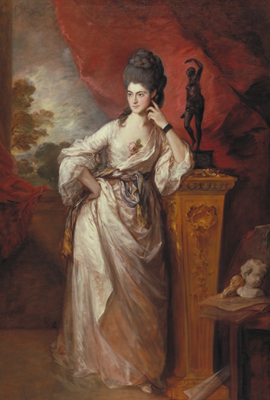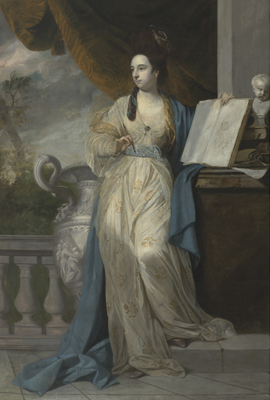The blog of The Huntington Library, Art Museum, and Botanical Gardens.
A Lurid Lady and Two Petulant Painters
Posted on Fri., April 1, 2011 by

Thomas Gainsborough (1727–1788) Penelope (Pitt), Viscountess Ligonier (1770), oil on canvas, copyright The Huntington Library, Art Collections, and Botanical Gardens.
Here's a scandal: While the Huntington painting Penelope (Pitt), Viscountess Ligonier immortalizes a woman who indulged in salacious affairs and managed to survive a very public divorce, its real story is not about the sitter at all.
The painting is one of a dozen portraits selected for the acclaimed traveling exhibition "Thomas Gainsborough and the Modern Woman." Melinda McCurdy, associate curator of British art at The Huntington, recently gave a talk at the San Diego Museum of Art, where the exhibition is on view through May 1, pointing out that Lady Ligonier's lurid biography has dominated virtually every report on the work since its 1771 appearance at the Royal Academy. But McCurdy tires of this episode of "Housewives of the English Gentry" and prefers to discuss how the painting illuminates a heated competition between the titans of 18th-century English art: Gainsborough and Joshua Reynolds.
In 1770, when the painting was made, it is likely that Gainsborough was contemplating a move from the quiet resort town of Bath to London, where the top painters competed for the most coveted commissions. Reynolds, on the other hand, was already well established as the head of the Royal Academy and the portraitist of choice for the noble classes.
"Even though these artists lived and worked in different cities, their portraits were often in direct competition with each other at the Royal Academy exhibitions," says McCurdy. "It's just possible that, with his portrait of Penelope Ligonier, Gainsborough took that rivalry one step further."

Sir Joshua Reynolds (1723–1792), Maria, Lady Broughton (1765–69), oil on canvas, from the collection of the Virginia Museum of Fine Arts, gift of Col. Henry W. Anderson, copyright VMFA.
Take a look at the painting (at top, returning to the Thornton Portrait Gallery after the close of the exhibition) and observe the composition—the downward left-to-right sweep of the crimson curtain, the hair draped over the right shoulder, and the arrangement of a paintbrush in left hand, sculpted putto head on the right, and even the slightly twisting position of the body and torso—all are elements of Reynolds' Maria, Lady Broughton (1765–69, owned by the Virginia Museum of Fine Arts). Do these references to Reynolds' picture reveal an artist attempting to improve on the work of a rival?
The way Gainsborough deviates from the Reynolds is the coup de grace. He adds personality to the subject with the strong angles of Penelope's arms and replaces Reynolds' smooth, sculpture-like drapery with a classically inspired wrap that shows off Gainsborough's famous talent for intense, brushy texture, shimmer, and translucency.
Within a few years of the Royal Academy exhibition of Viscountess Ligonier, Gainsborough made his move to London, where the rivalry between the two greatest English portraitists of the 18th century lived on. It wasn't until his competitor was in the grave that Reynolds was able to publicly praise his talents.
Thea M. Page is art writer and special projects manager at The Huntington.